University E-Learning Concepts and Principles INF4860 Assignment 3
VerifiedAdded on 2023/05/31
|17
|5120
|319
Report
AI Summary
This report, prepared for the INF4860 course at the University, examines e-learning concepts and principles through a multifaceted approach. It begins with a review of scholarly articles exploring the use of social media in teaching and learning, assessing its benefits and challenges. The report then presents and analyzes data from tables on student internet access points and ICT-related activities, categorizing students as HDS and HAS. Furthermore, it provides comments on three selected articles, discussing the implications of ICT in higher education. The analysis reveals insights into how students utilize technology for educational purposes, highlighting the disparities in access and usage. The assignment concludes with a literature review, synthesizing the key findings and drawing conclusions about the current state of e-learning and the future of social media in education. It emphasizes the need for educators to adapt their teaching methods to accommodate the evolving technological landscape and promote student engagement.
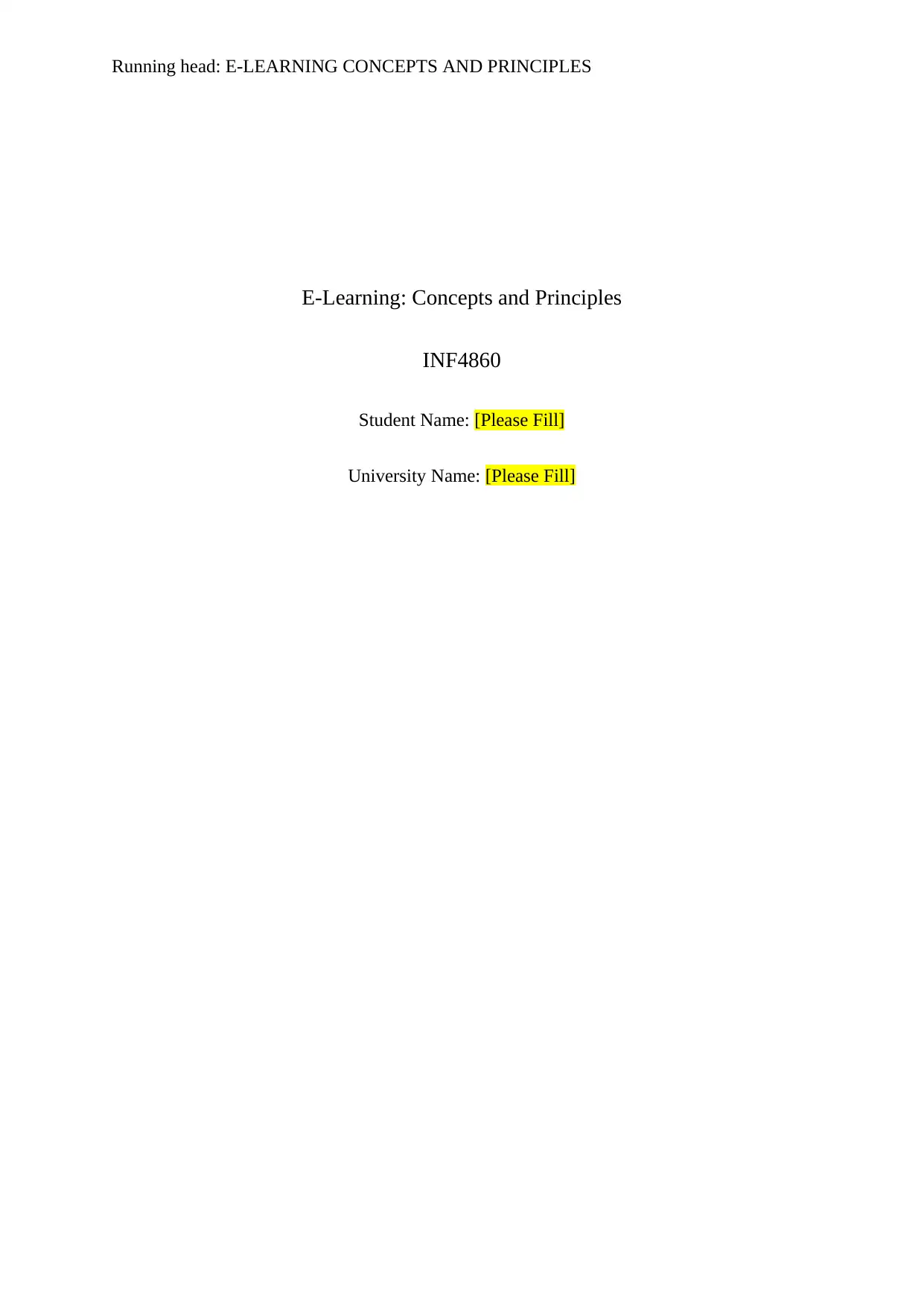
Running head: E-LEARNING CONCEPTS AND PRINCIPLES
E-Learning: Concepts and Principles
INF4860
Student Name: [Please Fill]
University Name: [Please Fill]
E-Learning: Concepts and Principles
INF4860
Student Name: [Please Fill]
University Name: [Please Fill]
Paraphrase This Document
Need a fresh take? Get an instant paraphrase of this document with our AI Paraphraser
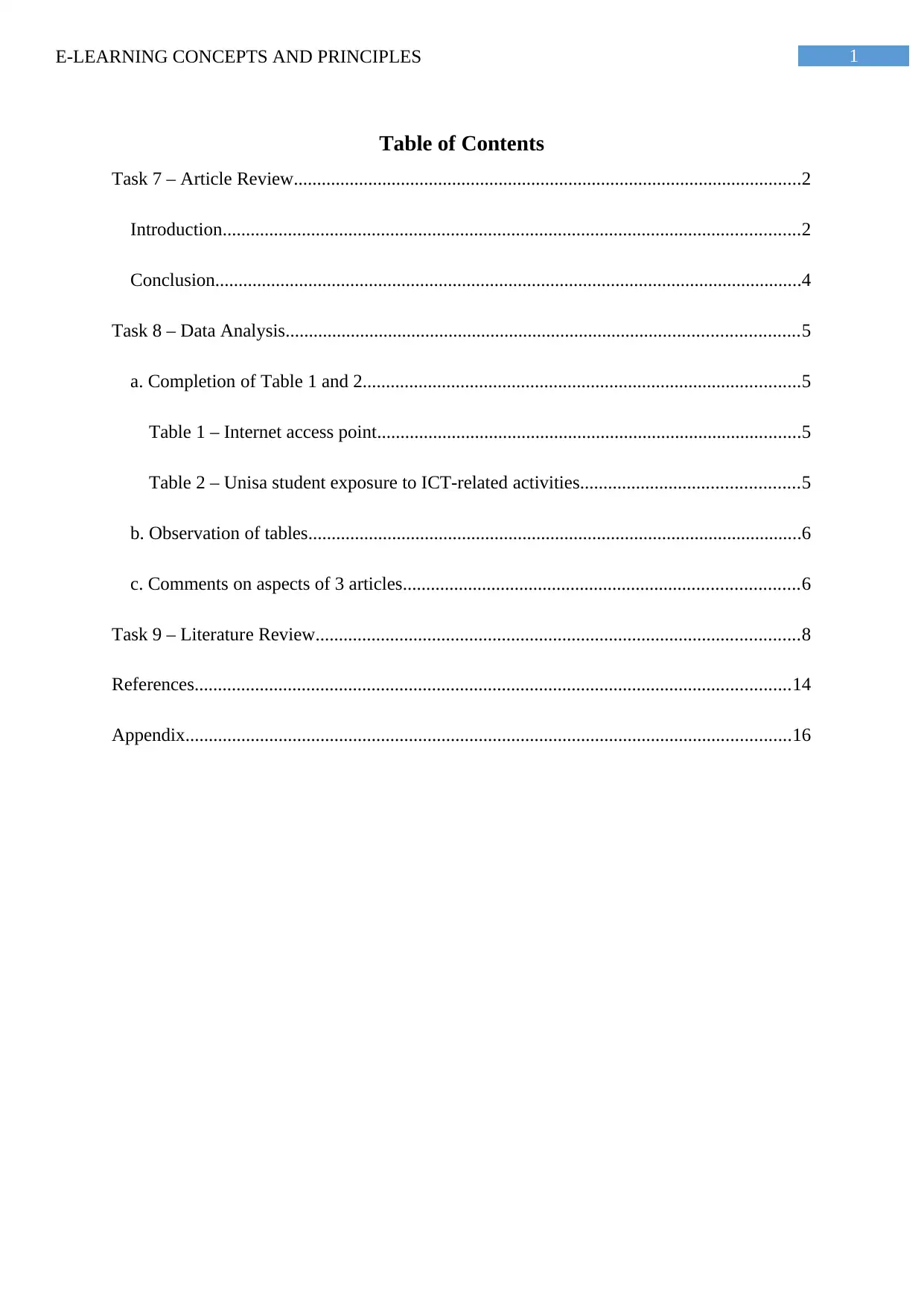
1E-LEARNING CONCEPTS AND PRINCIPLES
Table of Contents
Task 7 – Article Review.............................................................................................................2
Introduction............................................................................................................................2
Conclusion..............................................................................................................................4
Task 8 – Data Analysis..............................................................................................................5
a. Completion of Table 1 and 2..............................................................................................5
Table 1 – Internet access point...........................................................................................5
Table 2 – Unisa student exposure to ICT-related activities...............................................5
b. Observation of tables..........................................................................................................6
c. Comments on aspects of 3 articles.....................................................................................6
Task 9 – Literature Review........................................................................................................8
References................................................................................................................................14
Appendix..................................................................................................................................16
Table of Contents
Task 7 – Article Review.............................................................................................................2
Introduction............................................................................................................................2
Conclusion..............................................................................................................................4
Task 8 – Data Analysis..............................................................................................................5
a. Completion of Table 1 and 2..............................................................................................5
Table 1 – Internet access point...........................................................................................5
Table 2 – Unisa student exposure to ICT-related activities...............................................5
b. Observation of tables..........................................................................................................6
c. Comments on aspects of 3 articles.....................................................................................6
Task 9 – Literature Review........................................................................................................8
References................................................................................................................................14
Appendix..................................................................................................................................16
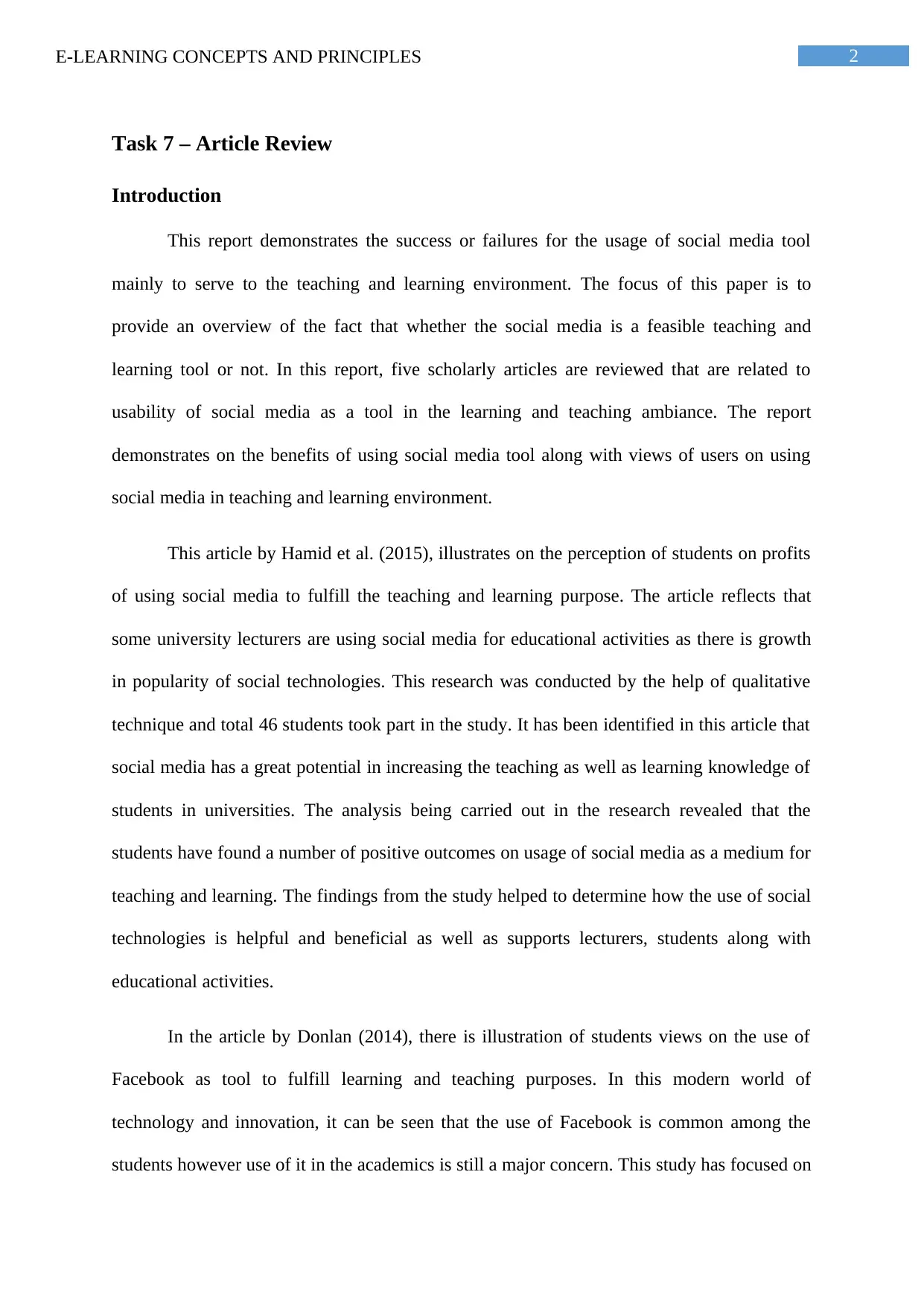
2E-LEARNING CONCEPTS AND PRINCIPLES
Task 7 – Article Review
Introduction
This report demonstrates the success or failures for the usage of social media tool
mainly to serve to the teaching and learning environment. The focus of this paper is to
provide an overview of the fact that whether the social media is a feasible teaching and
learning tool or not. In this report, five scholarly articles are reviewed that are related to
usability of social media as a tool in the learning and teaching ambiance. The report
demonstrates on the benefits of using social media tool along with views of users on using
social media in teaching and learning environment.
This article by Hamid et al. (2015), illustrates on the perception of students on profits
of using social media to fulfill the teaching and learning purpose. The article reflects that
some university lecturers are using social media for educational activities as there is growth
in popularity of social technologies. This research was conducted by the help of qualitative
technique and total 46 students took part in the study. It has been identified in this article that
social media has a great potential in increasing the teaching as well as learning knowledge of
students in universities. The analysis being carried out in the research revealed that the
students have found a number of positive outcomes on usage of social media as a medium for
teaching and learning. The findings from the study helped to determine how the use of social
technologies is helpful and beneficial as well as supports lecturers, students along with
educational activities.
In the article by Donlan (2014), there is illustration of students views on the use of
Facebook as tool to fulfill learning and teaching purposes. In this modern world of
technology and innovation, it can be seen that the use of Facebook is common among the
students however use of it in the academics is still a major concern. This study has focused on
Task 7 – Article Review
Introduction
This report demonstrates the success or failures for the usage of social media tool
mainly to serve to the teaching and learning environment. The focus of this paper is to
provide an overview of the fact that whether the social media is a feasible teaching and
learning tool or not. In this report, five scholarly articles are reviewed that are related to
usability of social media as a tool in the learning and teaching ambiance. The report
demonstrates on the benefits of using social media tool along with views of users on using
social media in teaching and learning environment.
This article by Hamid et al. (2015), illustrates on the perception of students on profits
of using social media to fulfill the teaching and learning purpose. The article reflects that
some university lecturers are using social media for educational activities as there is growth
in popularity of social technologies. This research was conducted by the help of qualitative
technique and total 46 students took part in the study. It has been identified in this article that
social media has a great potential in increasing the teaching as well as learning knowledge of
students in universities. The analysis being carried out in the research revealed that the
students have found a number of positive outcomes on usage of social media as a medium for
teaching and learning. The findings from the study helped to determine how the use of social
technologies is helpful and beneficial as well as supports lecturers, students along with
educational activities.
In the article by Donlan (2014), there is illustration of students views on the use of
Facebook as tool to fulfill learning and teaching purposes. In this modern world of
technology and innovation, it can be seen that the use of Facebook is common among the
students however use of it in the academics is still a major concern. This study has focused on
⊘ This is a preview!⊘
Do you want full access?
Subscribe today to unlock all pages.

Trusted by 1+ million students worldwide
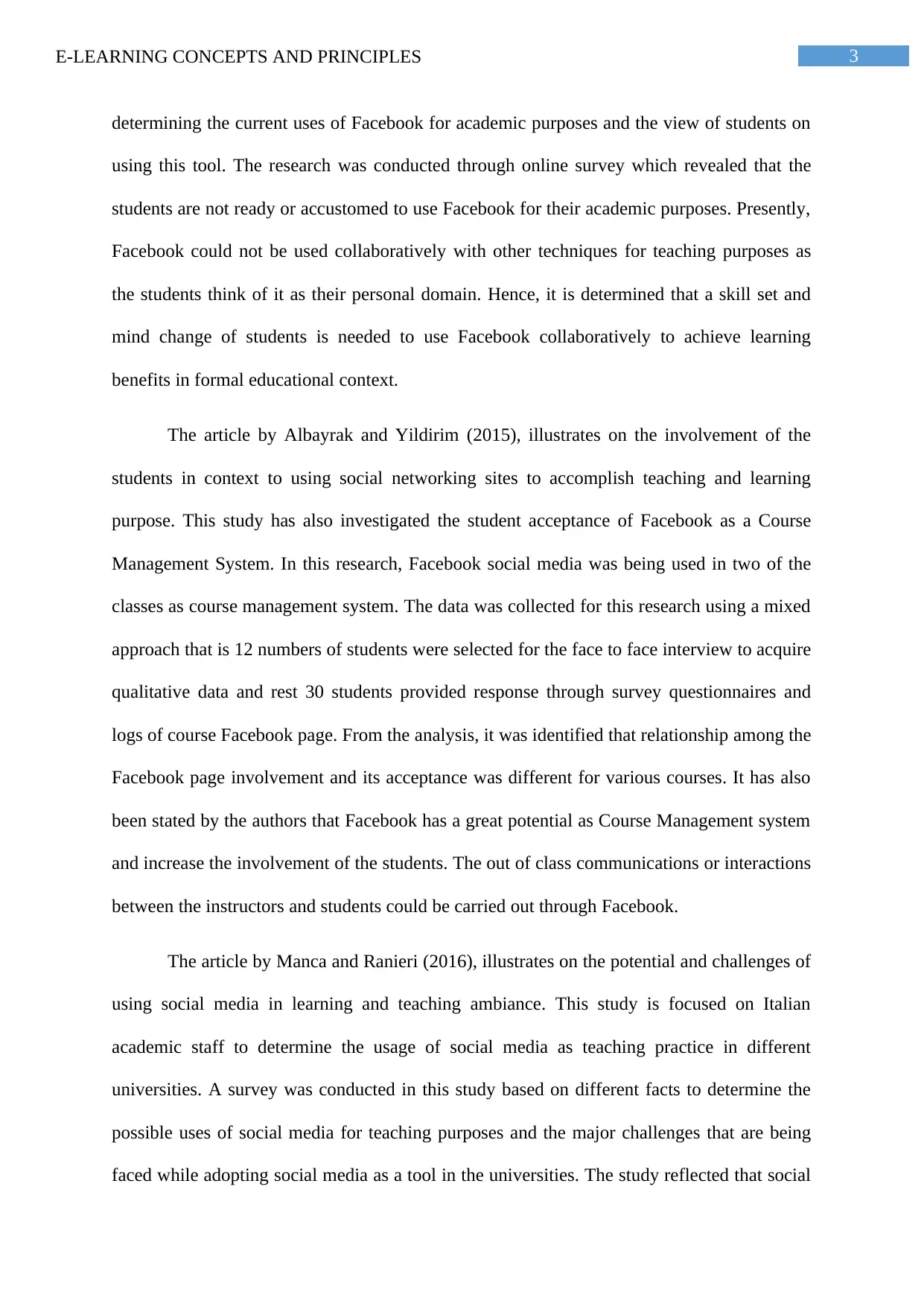
3E-LEARNING CONCEPTS AND PRINCIPLES
determining the current uses of Facebook for academic purposes and the view of students on
using this tool. The research was conducted through online survey which revealed that the
students are not ready or accustomed to use Facebook for their academic purposes. Presently,
Facebook could not be used collaboratively with other techniques for teaching purposes as
the students think of it as their personal domain. Hence, it is determined that a skill set and
mind change of students is needed to use Facebook collaboratively to achieve learning
benefits in formal educational context.
The article by Albayrak and Yildirim (2015), illustrates on the involvement of the
students in context to using social networking sites to accomplish teaching and learning
purpose. This study has also investigated the student acceptance of Facebook as a Course
Management System. In this research, Facebook social media was being used in two of the
classes as course management system. The data was collected for this research using a mixed
approach that is 12 numbers of students were selected for the face to face interview to acquire
qualitative data and rest 30 students provided response through survey questionnaires and
logs of course Facebook page. From the analysis, it was identified that relationship among the
Facebook page involvement and its acceptance was different for various courses. It has also
been stated by the authors that Facebook has a great potential as Course Management system
and increase the involvement of the students. The out of class communications or interactions
between the instructors and students could be carried out through Facebook.
The article by Manca and Ranieri (2016), illustrates on the potential and challenges of
using social media in learning and teaching ambiance. This study is focused on Italian
academic staff to determine the usage of social media as teaching practice in different
universities. A survey was conducted in this study based on different facts to determine the
possible uses of social media for teaching purposes and the major challenges that are being
faced while adopting social media as a tool in the universities. The study reflected that social
determining the current uses of Facebook for academic purposes and the view of students on
using this tool. The research was conducted through online survey which revealed that the
students are not ready or accustomed to use Facebook for their academic purposes. Presently,
Facebook could not be used collaboratively with other techniques for teaching purposes as
the students think of it as their personal domain. Hence, it is determined that a skill set and
mind change of students is needed to use Facebook collaboratively to achieve learning
benefits in formal educational context.
The article by Albayrak and Yildirim (2015), illustrates on the involvement of the
students in context to using social networking sites to accomplish teaching and learning
purpose. This study has also investigated the student acceptance of Facebook as a Course
Management System. In this research, Facebook social media was being used in two of the
classes as course management system. The data was collected for this research using a mixed
approach that is 12 numbers of students were selected for the face to face interview to acquire
qualitative data and rest 30 students provided response through survey questionnaires and
logs of course Facebook page. From the analysis, it was identified that relationship among the
Facebook page involvement and its acceptance was different for various courses. It has also
been stated by the authors that Facebook has a great potential as Course Management system
and increase the involvement of the students. The out of class communications or interactions
between the instructors and students could be carried out through Facebook.
The article by Manca and Ranieri (2016), illustrates on the potential and challenges of
using social media in learning and teaching ambiance. This study is focused on Italian
academic staff to determine the usage of social media as teaching practice in different
universities. A survey was conducted in this study based on different facts to determine the
possible uses of social media for teaching purposes and the major challenges that are being
faced while adopting social media as a tool in the universities. The study reflected that social
Paraphrase This Document
Need a fresh take? Get an instant paraphrase of this document with our AI Paraphraser
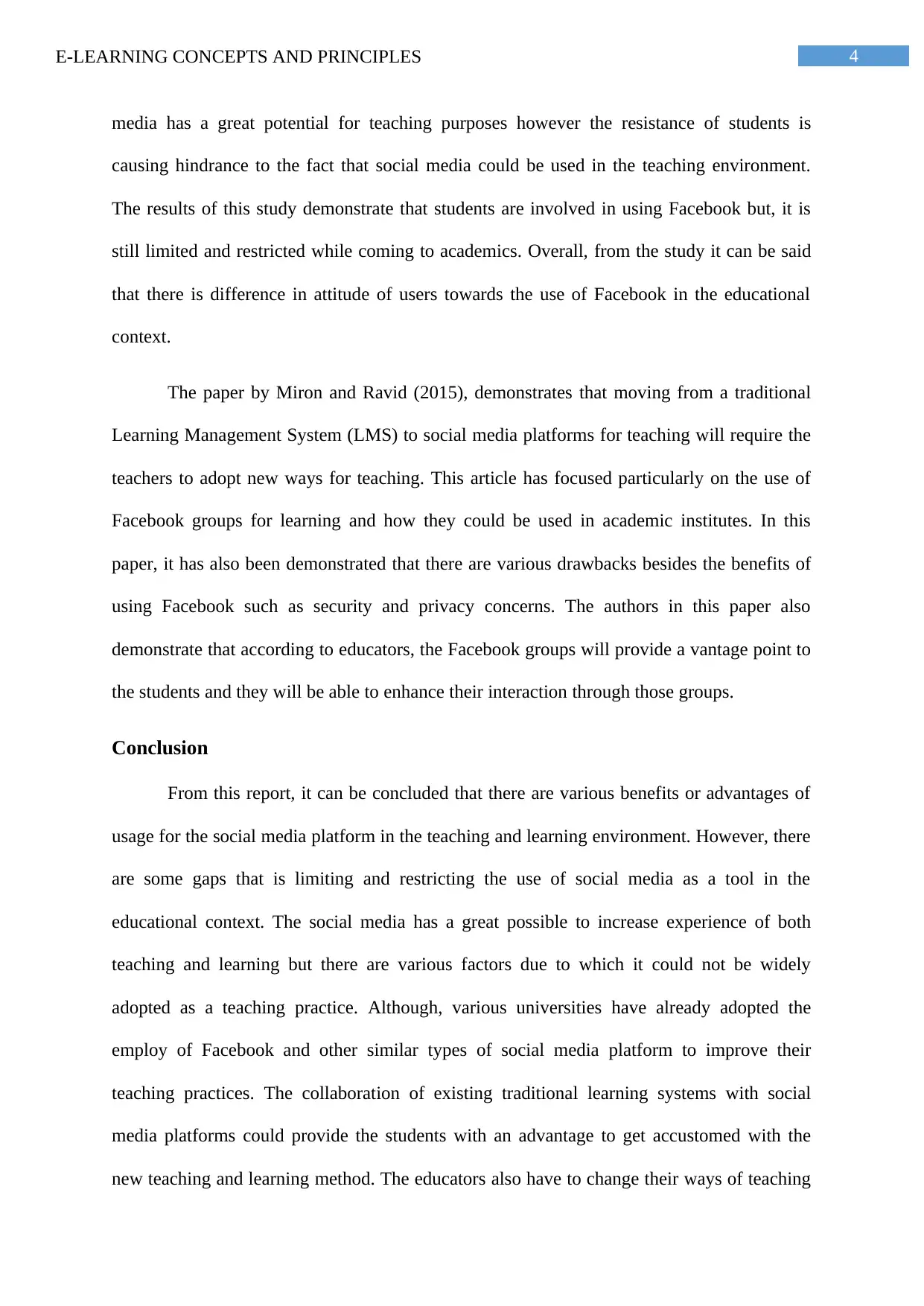
4E-LEARNING CONCEPTS AND PRINCIPLES
media has a great potential for teaching purposes however the resistance of students is
causing hindrance to the fact that social media could be used in the teaching environment.
The results of this study demonstrate that students are involved in using Facebook but, it is
still limited and restricted while coming to academics. Overall, from the study it can be said
that there is difference in attitude of users towards the use of Facebook in the educational
context.
The paper by Miron and Ravid (2015), demonstrates that moving from a traditional
Learning Management System (LMS) to social media platforms for teaching will require the
teachers to adopt new ways for teaching. This article has focused particularly on the use of
Facebook groups for learning and how they could be used in academic institutes. In this
paper, it has also been demonstrated that there are various drawbacks besides the benefits of
using Facebook such as security and privacy concerns. The authors in this paper also
demonstrate that according to educators, the Facebook groups will provide a vantage point to
the students and they will be able to enhance their interaction through those groups.
Conclusion
From this report, it can be concluded that there are various benefits or advantages of
usage for the social media platform in the teaching and learning environment. However, there
are some gaps that is limiting and restricting the use of social media as a tool in the
educational context. The social media has a great possible to increase experience of both
teaching and learning but there are various factors due to which it could not be widely
adopted as a teaching practice. Although, various universities have already adopted the
employ of Facebook and other similar types of social media platform to improve their
teaching practices. The collaboration of existing traditional learning systems with social
media platforms could provide the students with an advantage to get accustomed with the
new teaching and learning method. The educators also have to change their ways of teaching
media has a great potential for teaching purposes however the resistance of students is
causing hindrance to the fact that social media could be used in the teaching environment.
The results of this study demonstrate that students are involved in using Facebook but, it is
still limited and restricted while coming to academics. Overall, from the study it can be said
that there is difference in attitude of users towards the use of Facebook in the educational
context.
The paper by Miron and Ravid (2015), demonstrates that moving from a traditional
Learning Management System (LMS) to social media platforms for teaching will require the
teachers to adopt new ways for teaching. This article has focused particularly on the use of
Facebook groups for learning and how they could be used in academic institutes. In this
paper, it has also been demonstrated that there are various drawbacks besides the benefits of
using Facebook such as security and privacy concerns. The authors in this paper also
demonstrate that according to educators, the Facebook groups will provide a vantage point to
the students and they will be able to enhance their interaction through those groups.
Conclusion
From this report, it can be concluded that there are various benefits or advantages of
usage for the social media platform in the teaching and learning environment. However, there
are some gaps that is limiting and restricting the use of social media as a tool in the
educational context. The social media has a great possible to increase experience of both
teaching and learning but there are various factors due to which it could not be widely
adopted as a teaching practice. Although, various universities have already adopted the
employ of Facebook and other similar types of social media platform to improve their
teaching practices. The collaboration of existing traditional learning systems with social
media platforms could provide the students with an advantage to get accustomed with the
new teaching and learning method. The educators also have to change their ways of teaching
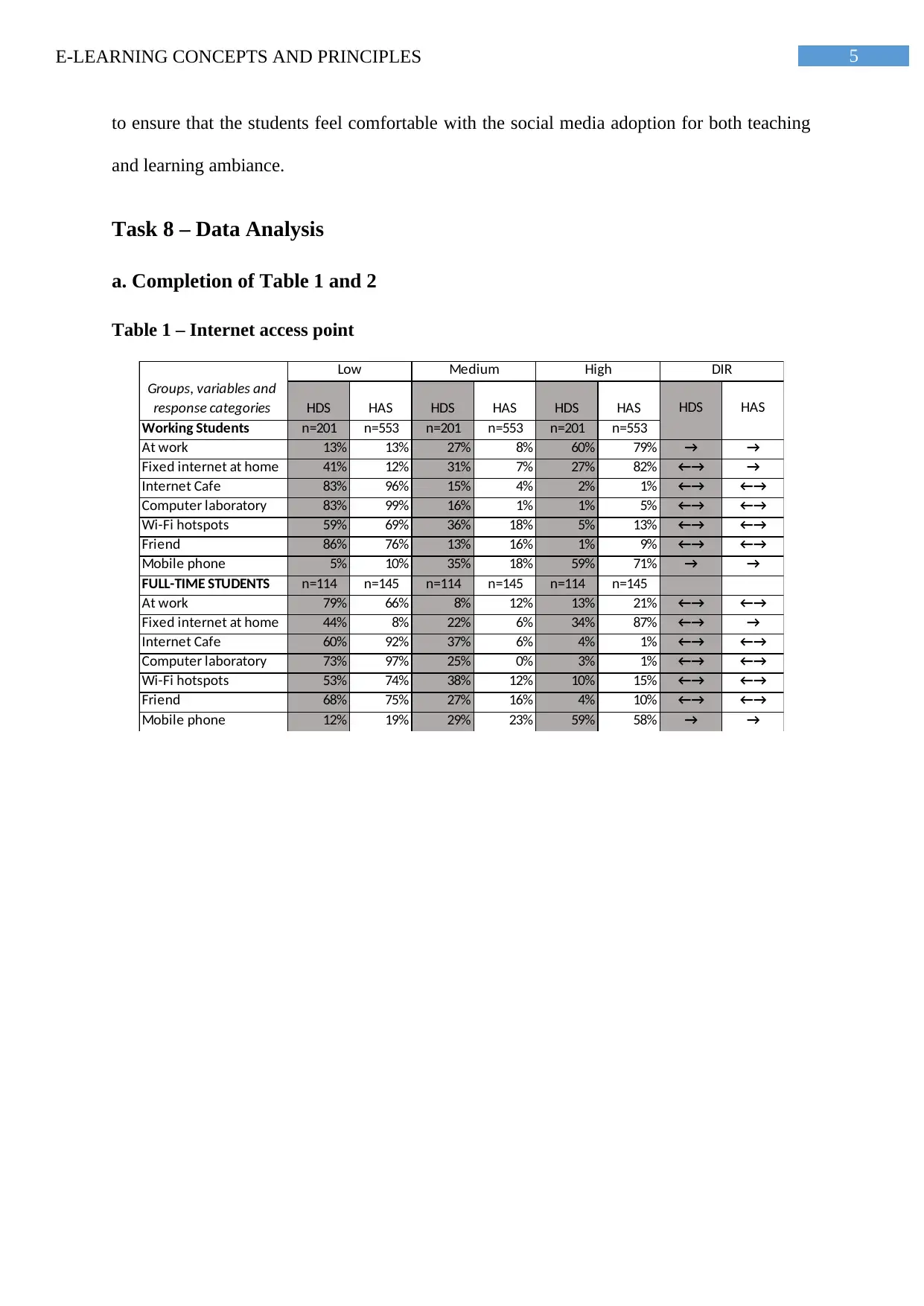
5E-LEARNING CONCEPTS AND PRINCIPLES
to ensure that the students feel comfortable with the social media adoption for both teaching
and learning ambiance.
Task 8 – Data Analysis
a. Completion of Table 1 and 2
Table 1 – Internet access point
HDS HAS HDS HAS HDS HAS
Working Students n=201 n=553 n=201 n=553 n=201 n=553
At work 13% 13% 27% 8% 60% 79% → →
Fixed internet at home 41% 12% 31% 7% 27% 82% ←→ →
Internet Cafe 83% 96% 15% 4% 2% 1% ←→ ←→
Computer laboratory 83% 99% 16% 1% 1% 5% ←→ ←→
Wi-Fi hotspots 59% 69% 36% 18% 5% 13% ←→ ←→
Friend 86% 76% 13% 16% 1% 9% ←→ ←→
Mobile phone 5% 10% 35% 18% 59% 71% → →
FULL-TIME STUDENTS n=114 n=145 n=114 n=145 n=114 n=145
At work 79% 66% 8% 12% 13% 21% ←→ ←→
Fixed internet at home 44% 8% 22% 6% 34% 87% ←→ →
Internet Cafe 60% 92% 37% 6% 4% 1% ←→ ←→
Computer laboratory 73% 97% 25% 0% 3% 1% ←→ ←→
Wi-Fi hotspots 53% 74% 38% 12% 10% 15% ←→ ←→
Friend 68% 75% 27% 16% 4% 10% ←→ ←→
Mobile phone 12% 19% 29% 23% 59% 58% → →
Groups, variables and
response categories
Low Medium High DIR
HDS HAS
to ensure that the students feel comfortable with the social media adoption for both teaching
and learning ambiance.
Task 8 – Data Analysis
a. Completion of Table 1 and 2
Table 1 – Internet access point
HDS HAS HDS HAS HDS HAS
Working Students n=201 n=553 n=201 n=553 n=201 n=553
At work 13% 13% 27% 8% 60% 79% → →
Fixed internet at home 41% 12% 31% 7% 27% 82% ←→ →
Internet Cafe 83% 96% 15% 4% 2% 1% ←→ ←→
Computer laboratory 83% 99% 16% 1% 1% 5% ←→ ←→
Wi-Fi hotspots 59% 69% 36% 18% 5% 13% ←→ ←→
Friend 86% 76% 13% 16% 1% 9% ←→ ←→
Mobile phone 5% 10% 35% 18% 59% 71% → →
FULL-TIME STUDENTS n=114 n=145 n=114 n=145 n=114 n=145
At work 79% 66% 8% 12% 13% 21% ←→ ←→
Fixed internet at home 44% 8% 22% 6% 34% 87% ←→ →
Internet Cafe 60% 92% 37% 6% 4% 1% ←→ ←→
Computer laboratory 73% 97% 25% 0% 3% 1% ←→ ←→
Wi-Fi hotspots 53% 74% 38% 12% 10% 15% ←→ ←→
Friend 68% 75% 27% 16% 4% 10% ←→ ←→
Mobile phone 12% 19% 29% 23% 59% 58% → →
Groups, variables and
response categories
Low Medium High DIR
HDS HAS
⊘ This is a preview!⊘
Do you want full access?
Subscribe today to unlock all pages.

Trusted by 1+ million students worldwide
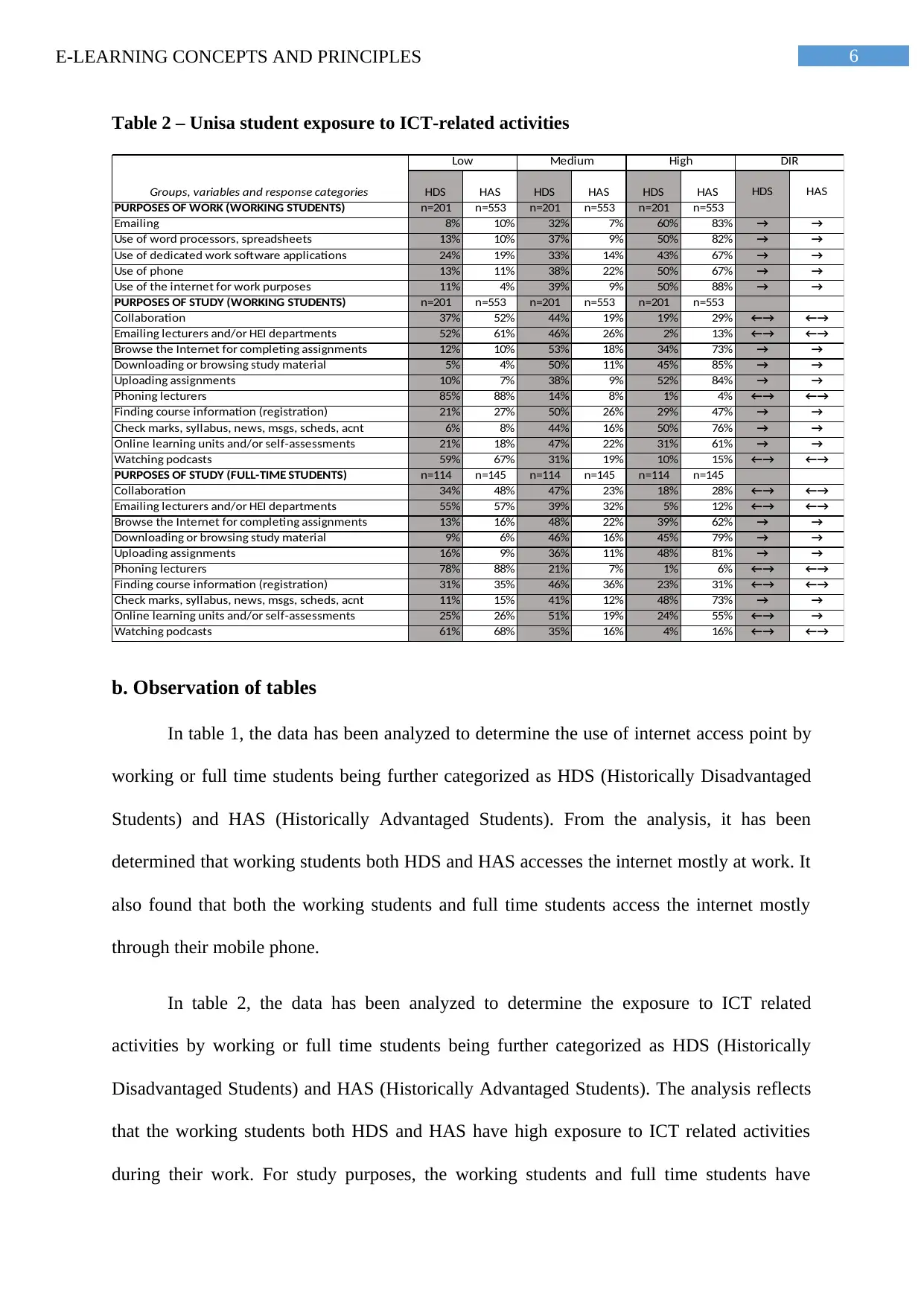
6E-LEARNING CONCEPTS AND PRINCIPLES
Table 2 – Unisa student exposure to ICT-related activities
HDS HAS HDS HAS HDS HAS
PURPOSES OF WORK (WORKING STUDENTS) n=201 n=553 n=201 n=553 n=201 n=553
Emailing 8% 10% 32% 7% 60% 83% → →
Use of word processors, spreadsheets 13% 10% 37% 9% 50% 82% → →
Use of dedicated work software applications 24% 19% 33% 14% 43% 67% → →
Use of phone 13% 11% 38% 22% 50% 67% → →
Use of the internet for work purposes 11% 4% 39% 9% 50% 88% → →
PURPOSES OF STUDY (WORKING STUDENTS) n=201 n=553 n=201 n=553 n=201 n=553
Collaboration 37% 52% 44% 19% 19% 29% ←→ ←→
Emailing lecturers and/or HEI departments 52% 61% 46% 26% 2% 13% ←→ ←→
Browse the Internet for completing assignments 12% 10% 53% 18% 34% 73% → →
Downloading or browsing study material 5% 4% 50% 11% 45% 85% → →
Uploading assignments 10% 7% 38% 9% 52% 84% → →
Phoning lecturers 85% 88% 14% 8% 1% 4% ←→ ←→
Finding course information (registration) 21% 27% 50% 26% 29% 47% → →
Check marks, syllabus, news, msgs, scheds, acnt 6% 8% 44% 16% 50% 76% → →
Online learning units and/or self-assessments 21% 18% 47% 22% 31% 61% → →
Watching podcasts 59% 67% 31% 19% 10% 15% ←→ ←→
PURPOSES OF STUDY (FULL-TIME STUDENTS) n=114 n=145 n=114 n=145 n=114 n=145
Collaboration 34% 48% 47% 23% 18% 28% ←→ ←→
Emailing lecturers and/or HEI departments 55% 57% 39% 32% 5% 12% ←→ ←→
Browse the Internet for completing assignments 13% 16% 48% 22% 39% 62% → →
Downloading or browsing study material 9% 6% 46% 16% 45% 79% → →
Uploading assignments 16% 9% 36% 11% 48% 81% → →
Phoning lecturers 78% 88% 21% 7% 1% 6% ←→ ←→
Finding course information (registration) 31% 35% 46% 36% 23% 31% ←→ ←→
Check marks, syllabus, news, msgs, scheds, acnt 11% 15% 41% 12% 48% 73% → →
Online learning units and/or self-assessments 25% 26% 51% 19% 24% 55% ←→ →
Watching podcasts 61% 68% 35% 16% 4% 16% ←→ ←→
Groups, variables and response categories
Low Medium High DIR
HDS HAS
b. Observation of tables
In table 1, the data has been analyzed to determine the use of internet access point by
working or full time students being further categorized as HDS (Historically Disadvantaged
Students) and HAS (Historically Advantaged Students). From the analysis, it has been
determined that working students both HDS and HAS accesses the internet mostly at work. It
also found that both the working students and full time students access the internet mostly
through their mobile phone.
In table 2, the data has been analyzed to determine the exposure to ICT related
activities by working or full time students being further categorized as HDS (Historically
Disadvantaged Students) and HAS (Historically Advantaged Students). The analysis reflects
that the working students both HDS and HAS have high exposure to ICT related activities
during their work. For study purposes, the working students and full time students have
Table 2 – Unisa student exposure to ICT-related activities
HDS HAS HDS HAS HDS HAS
PURPOSES OF WORK (WORKING STUDENTS) n=201 n=553 n=201 n=553 n=201 n=553
Emailing 8% 10% 32% 7% 60% 83% → →
Use of word processors, spreadsheets 13% 10% 37% 9% 50% 82% → →
Use of dedicated work software applications 24% 19% 33% 14% 43% 67% → →
Use of phone 13% 11% 38% 22% 50% 67% → →
Use of the internet for work purposes 11% 4% 39% 9% 50% 88% → →
PURPOSES OF STUDY (WORKING STUDENTS) n=201 n=553 n=201 n=553 n=201 n=553
Collaboration 37% 52% 44% 19% 19% 29% ←→ ←→
Emailing lecturers and/or HEI departments 52% 61% 46% 26% 2% 13% ←→ ←→
Browse the Internet for completing assignments 12% 10% 53% 18% 34% 73% → →
Downloading or browsing study material 5% 4% 50% 11% 45% 85% → →
Uploading assignments 10% 7% 38% 9% 52% 84% → →
Phoning lecturers 85% 88% 14% 8% 1% 4% ←→ ←→
Finding course information (registration) 21% 27% 50% 26% 29% 47% → →
Check marks, syllabus, news, msgs, scheds, acnt 6% 8% 44% 16% 50% 76% → →
Online learning units and/or self-assessments 21% 18% 47% 22% 31% 61% → →
Watching podcasts 59% 67% 31% 19% 10% 15% ←→ ←→
PURPOSES OF STUDY (FULL-TIME STUDENTS) n=114 n=145 n=114 n=145 n=114 n=145
Collaboration 34% 48% 47% 23% 18% 28% ←→ ←→
Emailing lecturers and/or HEI departments 55% 57% 39% 32% 5% 12% ←→ ←→
Browse the Internet for completing assignments 13% 16% 48% 22% 39% 62% → →
Downloading or browsing study material 9% 6% 46% 16% 45% 79% → →
Uploading assignments 16% 9% 36% 11% 48% 81% → →
Phoning lecturers 78% 88% 21% 7% 1% 6% ←→ ←→
Finding course information (registration) 31% 35% 46% 36% 23% 31% ←→ ←→
Check marks, syllabus, news, msgs, scheds, acnt 11% 15% 41% 12% 48% 73% → →
Online learning units and/or self-assessments 25% 26% 51% 19% 24% 55% ←→ →
Watching podcasts 61% 68% 35% 16% 4% 16% ←→ ←→
Groups, variables and response categories
Low Medium High DIR
HDS HAS
b. Observation of tables
In table 1, the data has been analyzed to determine the use of internet access point by
working or full time students being further categorized as HDS (Historically Disadvantaged
Students) and HAS (Historically Advantaged Students). From the analysis, it has been
determined that working students both HDS and HAS accesses the internet mostly at work. It
also found that both the working students and full time students access the internet mostly
through their mobile phone.
In table 2, the data has been analyzed to determine the exposure to ICT related
activities by working or full time students being further categorized as HDS (Historically
Disadvantaged Students) and HAS (Historically Advantaged Students). The analysis reflects
that the working students both HDS and HAS have high exposure to ICT related activities
during their work. For study purposes, the working students and full time students have
Paraphrase This Document
Need a fresh take? Get an instant paraphrase of this document with our AI Paraphraser
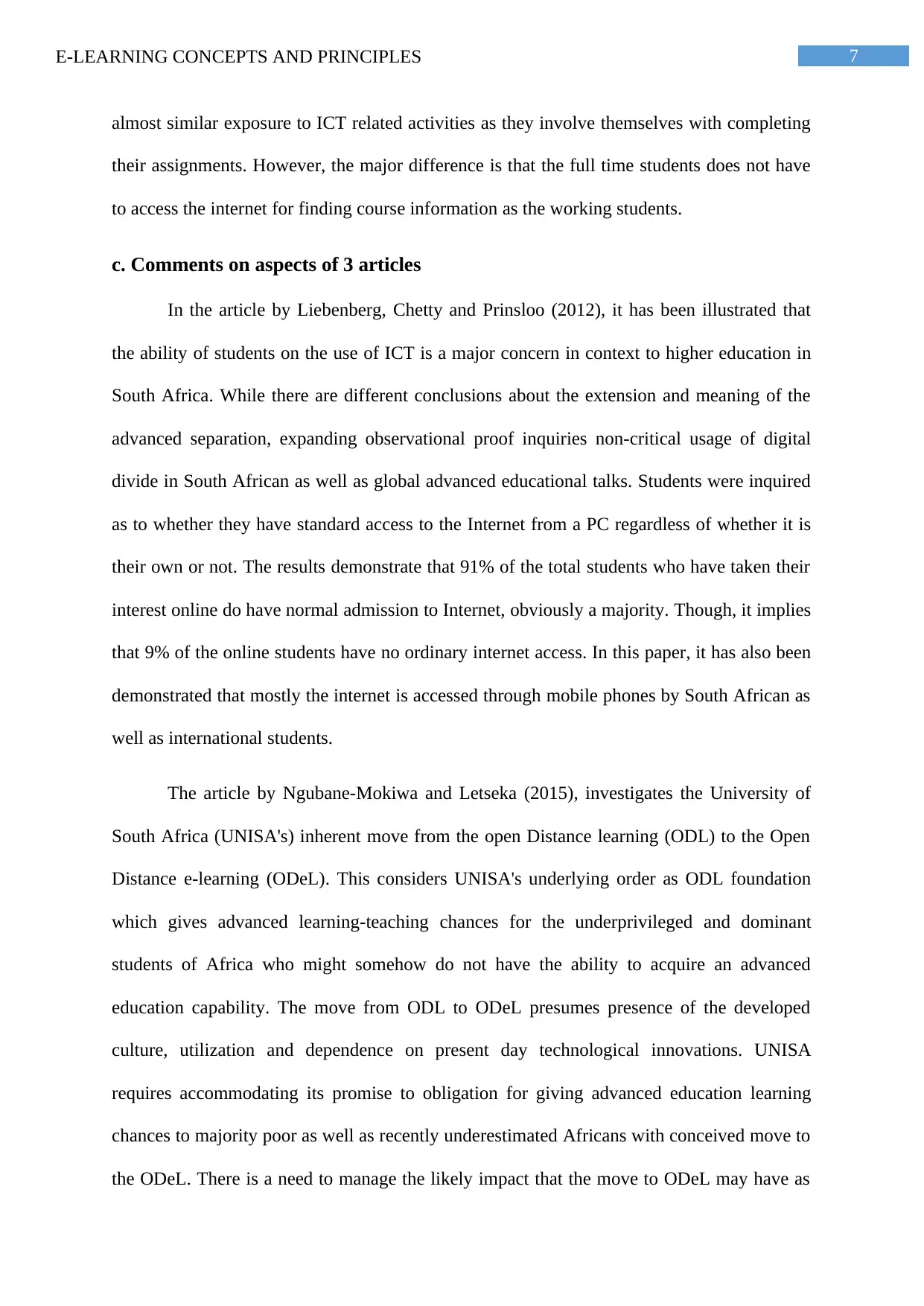
7E-LEARNING CONCEPTS AND PRINCIPLES
almost similar exposure to ICT related activities as they involve themselves with completing
their assignments. However, the major difference is that the full time students does not have
to access the internet for finding course information as the working students.
c. Comments on aspects of 3 articles
In the article by Liebenberg, Chetty and Prinsloo (2012), it has been illustrated that
the ability of students on the use of ICT is a major concern in context to higher education in
South Africa. While there are different conclusions about the extension and meaning of the
advanced separation, expanding observational proof inquiries non-critical usage of digital
divide in South African as well as global advanced educational talks. Students were inquired
as to whether they have standard access to the Internet from a PC regardless of whether it is
their own or not. The results demonstrate that 91% of the total students who have taken their
interest online do have normal admission to Internet, obviously a majority. Though, it implies
that 9% of the online students have no ordinary internet access. In this paper, it has also been
demonstrated that mostly the internet is accessed through mobile phones by South African as
well as international students.
The article by Ngubane-Mokiwa and Letseka (2015), investigates the University of
South Africa (UNISA's) inherent move from the open Distance learning (ODL) to the Open
Distance e-learning (ODeL). This considers UNISA's underlying order as ODL foundation
which gives advanced learning-teaching chances for the underprivileged and dominant
students of Africa who might somehow do not have the ability to acquire an advanced
education capability. The move from ODL to ODeL presumes presence of the developed
culture, utilization and dependence on present day technological innovations. UNISA
requires accommodating its promise to obligation for giving advanced education learning
chances to majority poor as well as recently underestimated Africans with conceived move to
the ODeL. There is a need to manage the likely impact that the move to ODeL may have as
almost similar exposure to ICT related activities as they involve themselves with completing
their assignments. However, the major difference is that the full time students does not have
to access the internet for finding course information as the working students.
c. Comments on aspects of 3 articles
In the article by Liebenberg, Chetty and Prinsloo (2012), it has been illustrated that
the ability of students on the use of ICT is a major concern in context to higher education in
South Africa. While there are different conclusions about the extension and meaning of the
advanced separation, expanding observational proof inquiries non-critical usage of digital
divide in South African as well as global advanced educational talks. Students were inquired
as to whether they have standard access to the Internet from a PC regardless of whether it is
their own or not. The results demonstrate that 91% of the total students who have taken their
interest online do have normal admission to Internet, obviously a majority. Though, it implies
that 9% of the online students have no ordinary internet access. In this paper, it has also been
demonstrated that mostly the internet is accessed through mobile phones by South African as
well as international students.
The article by Ngubane-Mokiwa and Letseka (2015), investigates the University of
South Africa (UNISA's) inherent move from the open Distance learning (ODL) to the Open
Distance e-learning (ODeL). This considers UNISA's underlying order as ODL foundation
which gives advanced learning-teaching chances for the underprivileged and dominant
students of Africa who might somehow do not have the ability to acquire an advanced
education capability. The move from ODL to ODeL presumes presence of the developed
culture, utilization and dependence on present day technological innovations. UNISA
requires accommodating its promise to obligation for giving advanced education learning
chances to majority poor as well as recently underestimated Africans with conceived move to
the ODeL. There is a need to manage the likely impact that the move to ODeL may have as
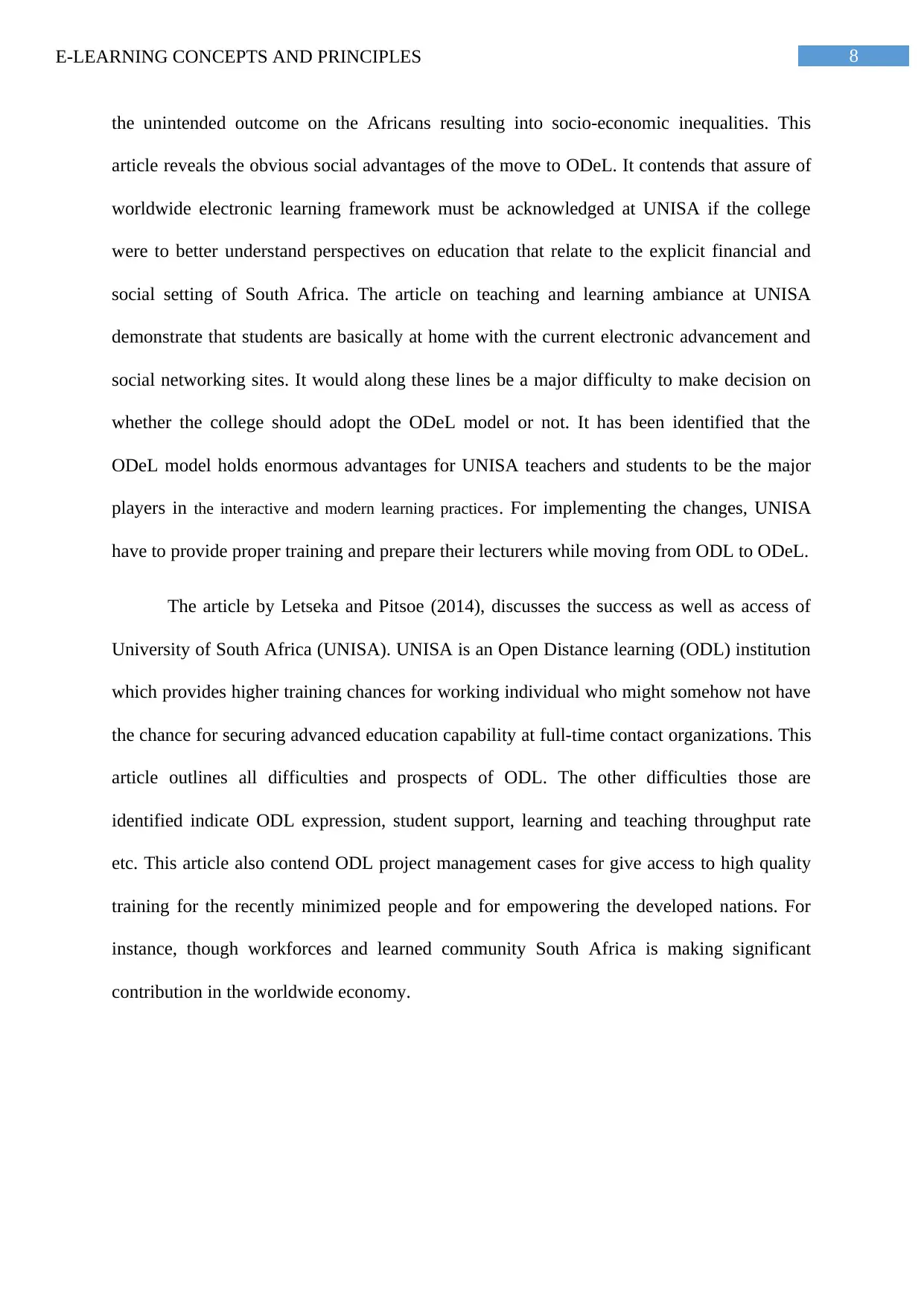
8E-LEARNING CONCEPTS AND PRINCIPLES
the unintended outcome on the Africans resulting into socio-economic inequalities. This
article reveals the obvious social advantages of the move to ODeL. It contends that assure of
worldwide electronic learning framework must be acknowledged at UNISA if the college
were to better understand perspectives on education that relate to the explicit financial and
social setting of South Africa. The article on teaching and learning ambiance at UNISA
demonstrate that students are basically at home with the current electronic advancement and
social networking sites. It would along these lines be a major difficulty to make decision on
whether the college should adopt the ODeL model or not. It has been identified that the
ODeL model holds enormous advantages for UNISA teachers and students to be the major
players in the interactive and modern learning practices. For implementing the changes, UNISA
have to provide proper training and prepare their lecturers while moving from ODL to ODeL.
The article by Letseka and Pitsoe (2014), discusses the success as well as access of
University of South Africa (UNISA). UNISA is an Open Distance learning (ODL) institution
which provides higher training chances for working individual who might somehow not have
the chance for securing advanced education capability at full-time contact organizations. This
article outlines all difficulties and prospects of ODL. The other difficulties those are
identified indicate ODL expression, student support, learning and teaching throughput rate
etc. This article also contend ODL project management cases for give access to high quality
training for the recently minimized people and for empowering the developed nations. For
instance, though workforces and learned community South Africa is making significant
contribution in the worldwide economy.
the unintended outcome on the Africans resulting into socio-economic inequalities. This
article reveals the obvious social advantages of the move to ODeL. It contends that assure of
worldwide electronic learning framework must be acknowledged at UNISA if the college
were to better understand perspectives on education that relate to the explicit financial and
social setting of South Africa. The article on teaching and learning ambiance at UNISA
demonstrate that students are basically at home with the current electronic advancement and
social networking sites. It would along these lines be a major difficulty to make decision on
whether the college should adopt the ODeL model or not. It has been identified that the
ODeL model holds enormous advantages for UNISA teachers and students to be the major
players in the interactive and modern learning practices. For implementing the changes, UNISA
have to provide proper training and prepare their lecturers while moving from ODL to ODeL.
The article by Letseka and Pitsoe (2014), discusses the success as well as access of
University of South Africa (UNISA). UNISA is an Open Distance learning (ODL) institution
which provides higher training chances for working individual who might somehow not have
the chance for securing advanced education capability at full-time contact organizations. This
article outlines all difficulties and prospects of ODL. The other difficulties those are
identified indicate ODL expression, student support, learning and teaching throughput rate
etc. This article also contend ODL project management cases for give access to high quality
training for the recently minimized people and for empowering the developed nations. For
instance, though workforces and learned community South Africa is making significant
contribution in the worldwide economy.
⊘ This is a preview!⊘
Do you want full access?
Subscribe today to unlock all pages.

Trusted by 1+ million students worldwide
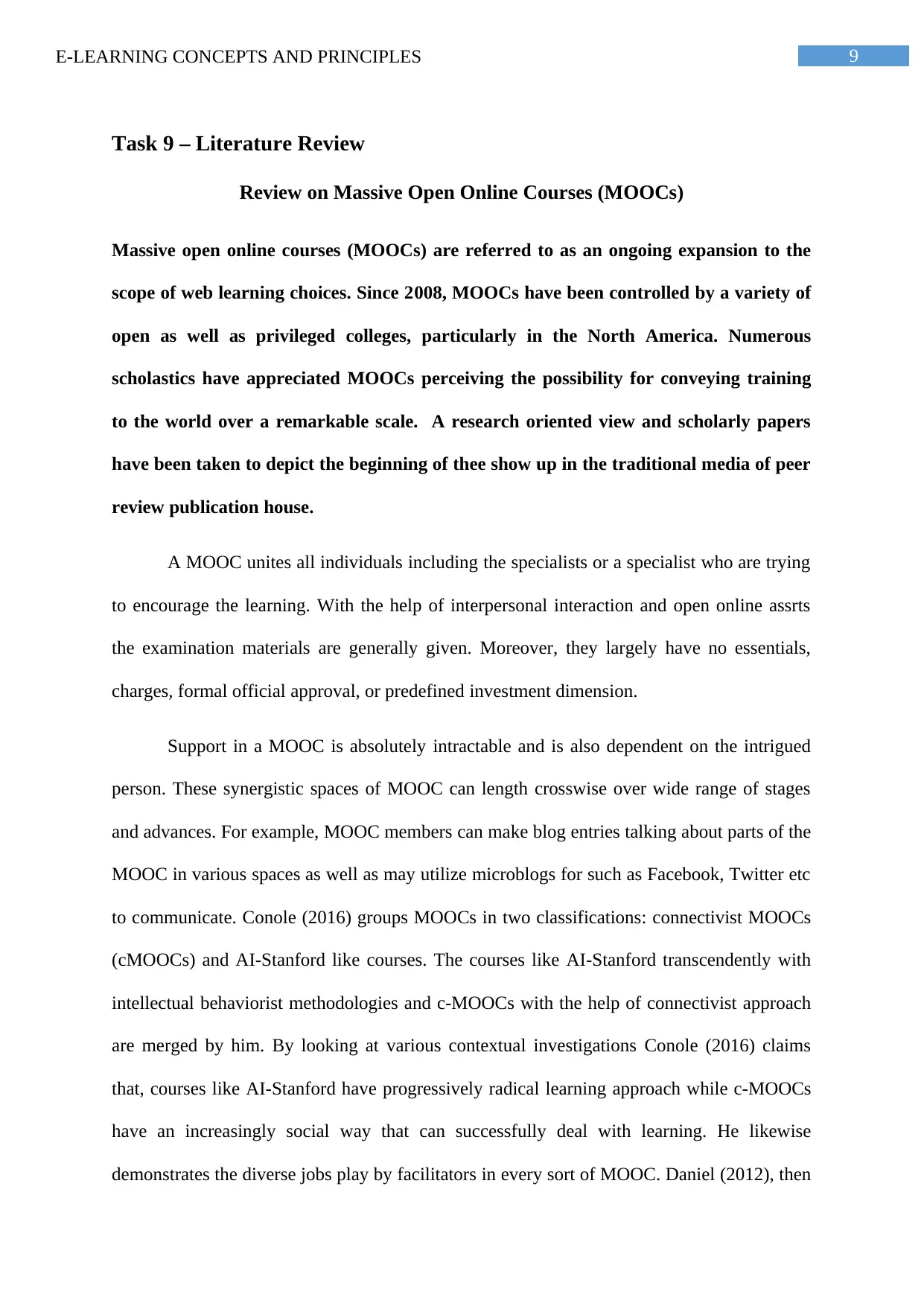
9E-LEARNING CONCEPTS AND PRINCIPLES
Task 9 – Literature Review
Review on Massive Open Online Courses (MOOCs)
Massive open online courses (MOOCs) are referred to as an ongoing expansion to the
scope of web learning choices. Since 2008, MOOCs have been controlled by a variety of
open as well as privileged colleges, particularly in the North America. Numerous
scholastics have appreciated MOOCs perceiving the possibility for conveying training
to the world over a remarkable scale. A research oriented view and scholarly papers
have been taken to depict the beginning of thee show up in the traditional media of peer
review publication house.
A MOOC unites all individuals including the specialists or a specialist who are trying
to encourage the learning. With the help of interpersonal interaction and open online assrts
the examination materials are generally given. Moreover, they largely have no essentials,
charges, formal official approval, or predefined investment dimension.
Support in a MOOC is absolutely intractable and is also dependent on the intrigued
person. These synergistic spaces of MOOC can length crosswise over wide range of stages
and advances. For example, MOOC members can make blog entries talking about parts of the
MOOC in various spaces as well as may utilize microblogs for such as Facebook, Twitter etc
to communicate. Conole (2016) groups MOOCs in two classifications: connectivist MOOCs
(cMOOCs) and AI-Stanford like courses. The courses like AI-Stanford transcendently with
intellectual behaviorist methodologies and c-MOOCs with the help of connectivist approach
are merged by him. By looking at various contextual investigations Conole (2016) claims
that, courses like AI-Stanford have progressively radical learning approach while c-MOOCs
have an increasingly social way that can successfully deal with learning. He likewise
demonstrates the diverse jobs play by facilitators in every sort of MOOC. Daniel (2012), then
Task 9 – Literature Review
Review on Massive Open Online Courses (MOOCs)
Massive open online courses (MOOCs) are referred to as an ongoing expansion to the
scope of web learning choices. Since 2008, MOOCs have been controlled by a variety of
open as well as privileged colleges, particularly in the North America. Numerous
scholastics have appreciated MOOCs perceiving the possibility for conveying training
to the world over a remarkable scale. A research oriented view and scholarly papers
have been taken to depict the beginning of thee show up in the traditional media of peer
review publication house.
A MOOC unites all individuals including the specialists or a specialist who are trying
to encourage the learning. With the help of interpersonal interaction and open online assrts
the examination materials are generally given. Moreover, they largely have no essentials,
charges, formal official approval, or predefined investment dimension.
Support in a MOOC is absolutely intractable and is also dependent on the intrigued
person. These synergistic spaces of MOOC can length crosswise over wide range of stages
and advances. For example, MOOC members can make blog entries talking about parts of the
MOOC in various spaces as well as may utilize microblogs for such as Facebook, Twitter etc
to communicate. Conole (2016) groups MOOCs in two classifications: connectivist MOOCs
(cMOOCs) and AI-Stanford like courses. The courses like AI-Stanford transcendently with
intellectual behaviorist methodologies and c-MOOCs with the help of connectivist approach
are merged by him. By looking at various contextual investigations Conole (2016) claims
that, courses like AI-Stanford have progressively radical learning approach while c-MOOCs
have an increasingly social way that can successfully deal with learning. He likewise
demonstrates the diverse jobs play by facilitators in every sort of MOOC. Daniel (2012), then
Paraphrase This Document
Need a fresh take? Get an instant paraphrase of this document with our AI Paraphraser
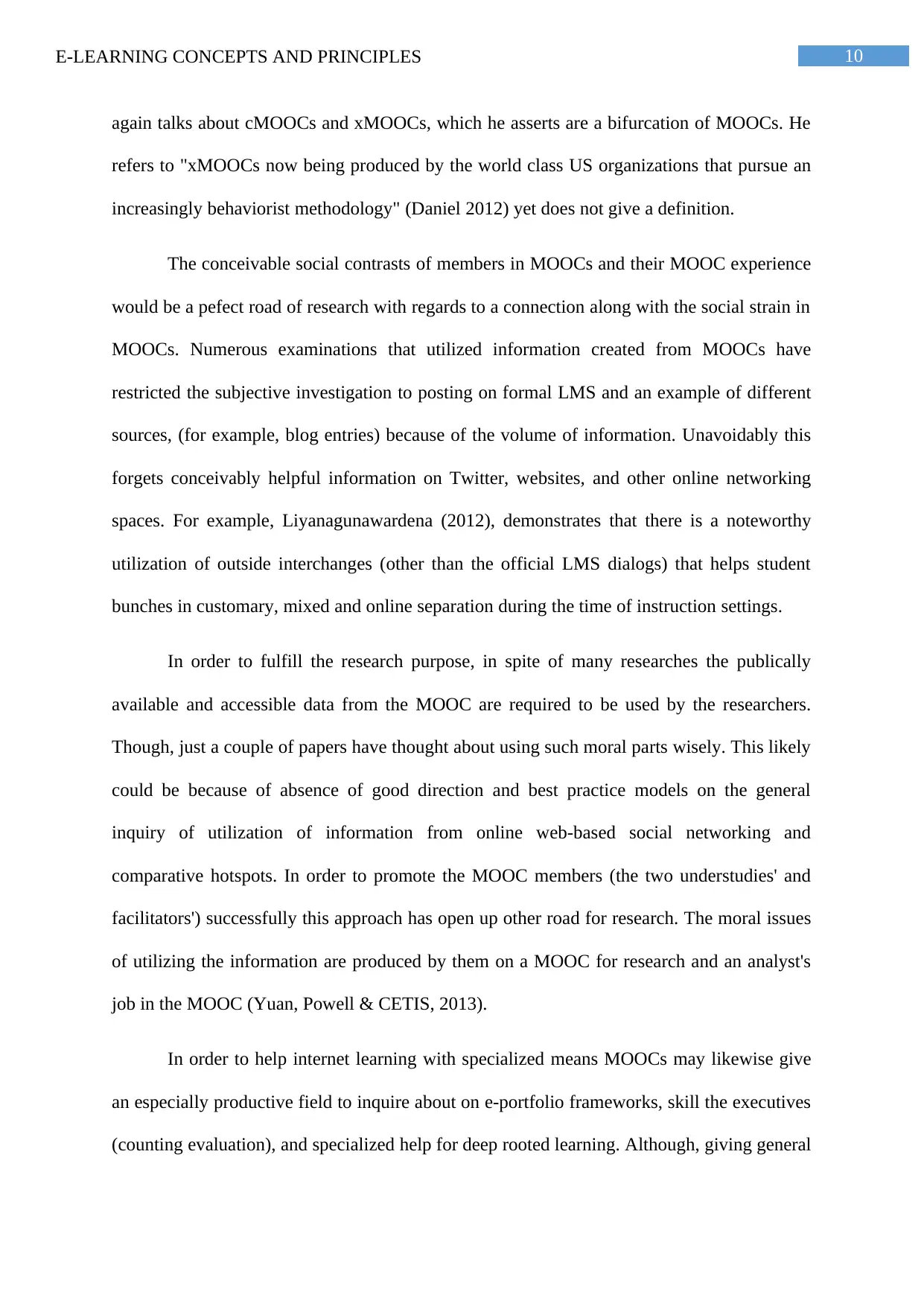
10E-LEARNING CONCEPTS AND PRINCIPLES
again talks about cMOOCs and xMOOCs, which he asserts are a bifurcation of MOOCs. He
refers to "xMOOCs now being produced by the world class US organizations that pursue an
increasingly behaviorist methodology" (Daniel 2012) yet does not give a definition.
The conceivable social contrasts of members in MOOCs and their MOOC experience
would be a pefect road of research with regards to a connection along with the social strain in
MOOCs. Numerous examinations that utilized information created from MOOCs have
restricted the subjective investigation to posting on formal LMS and an example of different
sources, (for example, blog entries) because of the volume of information. Unavoidably this
forgets conceivably helpful information on Twitter, websites, and other online networking
spaces. For example, Liyanagunawardena (2012), demonstrates that there is a noteworthy
utilization of outside interchanges (other than the official LMS dialogs) that helps student
bunches in customary, mixed and online separation during the time of instruction settings.
In order to fulfill the research purpose, in spite of many researches the publically
available and accessible data from the MOOC are required to be used by the researchers.
Though, just a couple of papers have thought about using such moral parts wisely. This likely
could be because of absence of good direction and best practice models on the general
inquiry of utilization of information from online web-based social networking and
comparative hotspots. In order to promote the MOOC members (the two understudies' and
facilitators') successfully this approach has open up other road for research. The moral issues
of utilizing the information are produced by them on a MOOC for research and an analyst's
job in the MOOC (Yuan, Powell & CETIS, 2013).
In order to help internet learning with specialized means MOOCs may likewise give
an especially productive field to inquire about on e-portfolio frameworks, skill the executives
(counting evaluation), and specialized help for deep rooted learning. Although, giving general
again talks about cMOOCs and xMOOCs, which he asserts are a bifurcation of MOOCs. He
refers to "xMOOCs now being produced by the world class US organizations that pursue an
increasingly behaviorist methodology" (Daniel 2012) yet does not give a definition.
The conceivable social contrasts of members in MOOCs and their MOOC experience
would be a pefect road of research with regards to a connection along with the social strain in
MOOCs. Numerous examinations that utilized information created from MOOCs have
restricted the subjective investigation to posting on formal LMS and an example of different
sources, (for example, blog entries) because of the volume of information. Unavoidably this
forgets conceivably helpful information on Twitter, websites, and other online networking
spaces. For example, Liyanagunawardena (2012), demonstrates that there is a noteworthy
utilization of outside interchanges (other than the official LMS dialogs) that helps student
bunches in customary, mixed and online separation during the time of instruction settings.
In order to fulfill the research purpose, in spite of many researches the publically
available and accessible data from the MOOC are required to be used by the researchers.
Though, just a couple of papers have thought about using such moral parts wisely. This likely
could be because of absence of good direction and best practice models on the general
inquiry of utilization of information from online web-based social networking and
comparative hotspots. In order to promote the MOOC members (the two understudies' and
facilitators') successfully this approach has open up other road for research. The moral issues
of utilizing the information are produced by them on a MOOC for research and an analyst's
job in the MOOC (Yuan, Powell & CETIS, 2013).
In order to help internet learning with specialized means MOOCs may likewise give
an especially productive field to inquire about on e-portfolio frameworks, skill the executives
(counting evaluation), and specialized help for deep rooted learning. Although, giving general
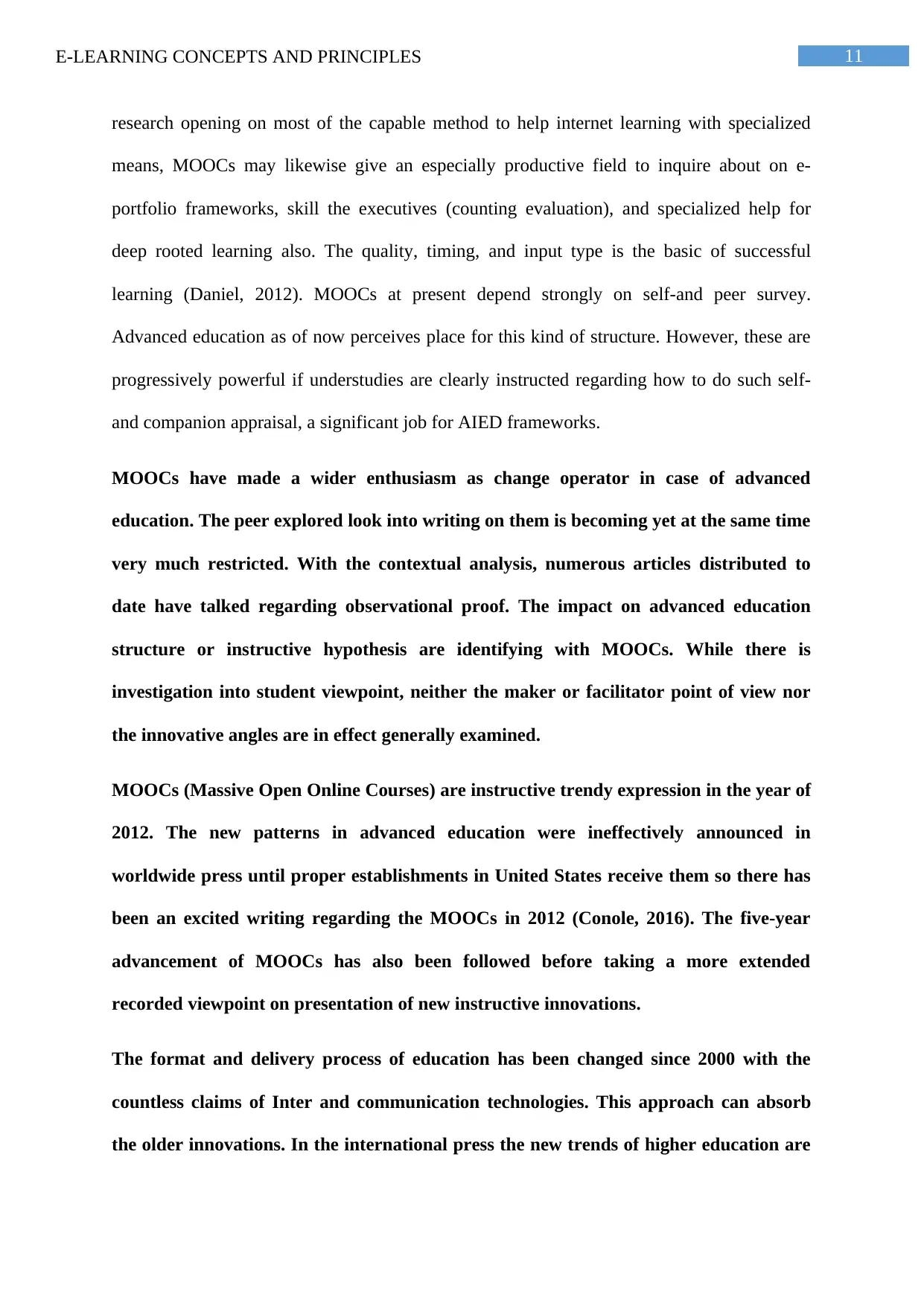
11E-LEARNING CONCEPTS AND PRINCIPLES
research opening on most of the capable method to help internet learning with specialized
means, MOOCs may likewise give an especially productive field to inquire about on e-
portfolio frameworks, skill the executives (counting evaluation), and specialized help for
deep rooted learning also. The quality, timing, and input type is the basic of successful
learning (Daniel, 2012). MOOCs at present depend strongly on self-and peer survey.
Advanced education as of now perceives place for this kind of structure. However, these are
progressively powerful if understudies are clearly instructed regarding how to do such self-
and companion appraisal, a significant job for AIED frameworks.
MOOCs have made a wider enthusiasm as change operator in case of advanced
education. The peer explored look into writing on them is becoming yet at the same time
very much restricted. With the contextual analysis, numerous articles distributed to
date have talked regarding observational proof. The impact on advanced education
structure or instructive hypothesis are identifying with MOOCs. While there is
investigation into student viewpoint, neither the maker or facilitator point of view nor
the innovative angles are in effect generally examined.
MOOCs (Massive Open Online Courses) are instructive trendy expression in the year of
2012. The new patterns in advanced education were ineffectively announced in
worldwide press until proper establishments in United States receive them so there has
been an excited writing regarding the MOOCs in 2012 (Conole, 2016). The five-year
advancement of MOOCs has also been followed before taking a more extended
recorded viewpoint on presentation of new instructive innovations.
The format and delivery process of education has been changed since 2000 with the
countless claims of Inter and communication technologies. This approach can absorb
the older innovations. In the international press the new trends of higher education are
research opening on most of the capable method to help internet learning with specialized
means, MOOCs may likewise give an especially productive field to inquire about on e-
portfolio frameworks, skill the executives (counting evaluation), and specialized help for
deep rooted learning also. The quality, timing, and input type is the basic of successful
learning (Daniel, 2012). MOOCs at present depend strongly on self-and peer survey.
Advanced education as of now perceives place for this kind of structure. However, these are
progressively powerful if understudies are clearly instructed regarding how to do such self-
and companion appraisal, a significant job for AIED frameworks.
MOOCs have made a wider enthusiasm as change operator in case of advanced
education. The peer explored look into writing on them is becoming yet at the same time
very much restricted. With the contextual analysis, numerous articles distributed to
date have talked regarding observational proof. The impact on advanced education
structure or instructive hypothesis are identifying with MOOCs. While there is
investigation into student viewpoint, neither the maker or facilitator point of view nor
the innovative angles are in effect generally examined.
MOOCs (Massive Open Online Courses) are instructive trendy expression in the year of
2012. The new patterns in advanced education were ineffectively announced in
worldwide press until proper establishments in United States receive them so there has
been an excited writing regarding the MOOCs in 2012 (Conole, 2016). The five-year
advancement of MOOCs has also been followed before taking a more extended
recorded viewpoint on presentation of new instructive innovations.
The format and delivery process of education has been changed since 2000 with the
countless claims of Inter and communication technologies. This approach can absorb
the older innovations. In the international press the new trends of higher education are
⊘ This is a preview!⊘
Do you want full access?
Subscribe today to unlock all pages.

Trusted by 1+ million students worldwide
1 out of 17
Related Documents
Your All-in-One AI-Powered Toolkit for Academic Success.
+13062052269
info@desklib.com
Available 24*7 on WhatsApp / Email
![[object Object]](/_next/static/media/star-bottom.7253800d.svg)
Unlock your academic potential
Copyright © 2020–2025 A2Z Services. All Rights Reserved. Developed and managed by ZUCOL.





